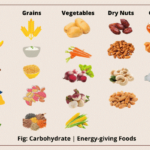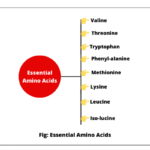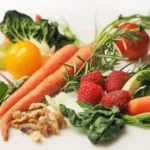30 Fats Quiz – MCQ Questions for Exams
Welcome to this Ultimate Fats Quiz! This MCQ quiz contains 30 multiple-choice questions based on fats, which will test knowledge in fats as well as also enhance your knowledge through explanations provided.
These 30 questions are very important for those who are biology students or preparing for the competitive exams like NEET, SSC CGL, RRB, UPSC, IES, etc. So, are you ready to test your knowledge and score 30/30? Let’s start from the question number 1.

1. What are fats chemically made up of?
A. Amino acids
B. Fatty acids and glycerol
C. Nucleotides
D. Glucose
b
Fats are esters formed from glycerol, fatty acids, and a mixture of lipids. They are also called triglycerides.
2. Which of the following best represents the general chemical formula of a typical natural fat (triglyceride)?
A. C₅₇H₁₁₀O₆
B. C₆H₁₂O₆
C. C₁₂H₂₂O₁₁
D. C₂₇H₄₆O
a
A typical natural fat (like tristearin) is a triglyceride formed from glycerol and three fatty acids. The general formula of a common natural fat (triglyceride) is approximately C₅₅H₉₈O₆ to C₅₇H₁₁₀O₆ depending on the type of fatty acids whether they are saturated or unsaturated. For example, Tristearin is a common natural fat whose the general formula is C₅₇H₁₁₀O₆.
3. The molecule C₅₇H₁₁₀O₆ is formed by the combination of:
A. 2 glucose molecules
B. 1 cholesterol and 1 fatty acid
C. 3 glycerol molecules and 1 fatty acid
D. 1 glycerol and 3 stearic acids
d
Glycerol (C₃H₈O₃) + 3 Stearic Acids (C₁₈H₃₆O₂ each) undergo esterification. C₃H₈O₃ + 3 × C₁₈H₃₆O₂ = C₅₄H₁₀₈O₆ + 3 water molecules.
4. Which of the following are the main functions of fats in the human body?
A. Provides energy reserves
B. Providing essential fatty acids
C. Giving protection to sensitive organs of body
D. All of the above
d
All are the main functions of fats in human body.
5. Which type of fat is considered the most harmful for heart health?
A. Saturated fats
B. Monounsaturated fats
C. Polyunsaturated fats
D. Trans fats
d
Trans fats increase the level of bad cholesterol (LDL) and lower good cholesterol (HDL), significantly increasing the risk of heart disease.
6. Which vitamin is not fat-soluble?
A. Vitamin A
B. Vitamin D
C. Vitamin C
D. Vitamin E
c
Vitamins A, D, E, and K are fat-soluble vitamins. Vitamin C is water-soluble.
7. Which type of fatty acid has no double bond between carbon atoms?
A. Monounsaturated fatty acid
B. Polyunsaturated fatty acid
C. Saturated fatty acid
D. Essential fatty acid
c
Saturated fatty acids have only single bonds between carbons of molecular chains. They are usually solid at room temperature. If the fatty acids contain one or more double bonds between the carbons of the chain, they are called unsaturated fatty acids.
8. Which of the following is an essential fatty acid?
A. Oleic acid
B. Linoleic acid
C. Stearic acid
D. Palmitic acid
b
Linoleic acid (Omega-6 fatty acid), linolenic acid, and arachidonic acid are essential fatty acids because the human body cannot synthesize them and must obtain it through diet. Palmitic acid and stearic acid are examples of saturated fatty acids.
9. Which of the following tissues are often called the “Fat Depot of the body”?
A. Muscular tissue
B. Epithelial tissue
C. Adipose tissue
D. Connective tissue
c
Adipose tissue is a specialized type of connective tissue that acts as a storage of fats in the form of triglycerides. Therefore, it is also called fat depot of the body. It stores energy, insulates the body and cushion vital organs. It can be found under the skin, around internal organs, and in bone marrow and muscles.
10. What is the main component of animal fats?
A. Unsaturated fatty acids
B. Saturated fatty acids
C. Proteins
D. Steroids
b
Animal fats are mainly made up of saturated fats, which are solid at room temperature. For example, butter is an animal fat.
11. The major storage form of fat in the human body is:
A. Phospholipid
B. Cholesterol
C. Triglyceride
D. Free fatty acid
c
Fats are the mixture of lipids (Triglycerides), which are made of one glycerol molecule linked to three fatty acids. They are stored in adipose tissue as an energy reserve.
12. Which of the following is a saturated fat vegetable oil?
A. Soybean oil
B. Sunflower oil
C. Coconut oil
D. Olive oil
c
Coconut oil and palm oil are the only saturated vegetable oil. Unsaturated fatty acids are found in fish oil and vegetable oil.
13. Which of the following macronutrients provides the maximum energy per gram?
A. Proteins
B. Carbohydrates
C. Vitamins
D. Fats
d
Fats provide 9 kcal/g, while carbohydrates and proteins provide 4 kcal/g.
14. Which one of the following vitamins is stored in fat tissues in the human body?
A. Vitamin B1
B. Vitamin C
C. Vitamin D
D. Vitamin B12
C
Fat-soluble vitamins (A, D, E, K) are stored in the body’s liver and fatty tissues.
15. Hydrogenation of oils leads to the formation of which type of fats?
A. Polyunsaturated fats
B. Trans fats
C. Monounsaturated fats
D. Omega-3 fats
b
Hydrogenation adds hydrogen to vegetable oils, which converts them into solid fats (known as trans fats). These fats are unhealthy.
16. Which lipoprotein is often referred to as “good cholesterol”?
A. Very low-density lipoprotein (VLDL)
B. Low-density lipoprotein (LDL)
C. High-density lipoprotein (HDL)
D. Intermediate-density lipoprotein (IDL)
c
High-density lipoprotein (HDL) is the lipoprotein often referred to as “good cholesterol” because it helps to remove excess cholesterol from the arteries and carries it back to the liver for removal from the body.
17. Which enzyme is responsible for the digestion of fats in the small intestine?
A. Amylase
B. Pepsin
C. Trypsin
D. Lipase
d
Pancreatic lipase breaks fats into free fatty acids and monoglycerides in the small intestine.
18. Which of the following statements is incorrect about unsaturated fats?
A. They contain one or more double bonds.
B. They are usually liquid at room temperature.
C. They are mainly found in animal products.
D. They are considered healthier than saturated fats.
c
Unsaturated fats are mainly found in plant oils (e.g., olive oil, sunflower oil) and fish oil, not in animal products.
19. Which of the following is an example of Omega-3 fatty acid?
A. Linoleic acid
B. Arachidonic acid
C. Alpha-linolenic acid
D. Palmitic acid
c
Alpha-linolenic acid (ALA), eicosapentaenoic acid (EPA), and docosahexaenoic acid (DHA) are the three main omega-3 fatty acids.
20. Which organ is mainly responsible for the synthesis of cholesterol?
A. Pancreas
B. Liver
C. Small intestine
D. Kidney
b
The liver synthesizes most of the cholesterol in the human body, which is essential for cell membranes, hormone production, and bile acids.
21. The process of breaking down fat (fatty acids) to produce energy is called
A. Beta-oxidation
B. Glycolysis
C. Hydrolysis
D. Saponification
a
The process of breaking down fat (fatty acids) to produce energy is called beta-oxidation. This process occurs in the mitochondria of cells.
22. The deficiency of essential fatty acids leads to
A. Scurvy
B. Xerophthalmia
C. Dermatitis
D. Rickets
c
A deficiency in essential fatty acids can lead to illnesses such as dermatitis, phrynoderma start in the skin.
23. Which organ produces bile salts essential for fat digestion in the human body?
A. Pancreas
B. Gallbladder
C. Small intestine
D. Liver
d
The liver produces bile salts, which are essential for fat digestion. Bile, which contains bile salts, is a fluid that is produced and released by the liver and stored in the gallbladder. Bile helps with digestion.
24. Omega-3 fatty acids are mainly found in
A. Meat
B. Green leafy vegetables
C. Butter
D. Fish oils
d
Omega-3 fatty acids are mainly found in fish oil.
25. Which part of the small intestine is mainly involved in fat absorption?
A. Duodenum
B. Jejunum
C. Ileum
D. Colon
b
The jejunum is the middle part of the small intestine, which is mainly responsible for fat absorption.
26. Which organ of the human body stores the least fat?
A. Liver
B. Brain
C. Kidney
D. Bone marrow
c
The kidney stores almost no fat for energy.
27. Adipose tissue secretes which hormone?
A. Insulin
B. Leptin
C. Thyroxine
D. Adrenaline
b
Adipose tissue mainly secretes the hormone named leptin, which plays a crucial role in regulating appetite, energy expenditure, and energy balance.
28. How many ATP molecules are produced from one 18-carbon fatty acid?
A. 36 ATP
B. 108 ATP
C. 120 ATP
D. 146 ATP
c
The Net ATP production from the complete oxidation of 18 fatty acid is 120.
29. Which fat is most strongly helped to lower the risk of heart disease?
A. Trans fats
B. Omega-6 fatty acids
C. Omega-3 fatty acids
D. Saturated fat
c
Omega-3 fatty acids found in fish oil, flaxseeds, walnuts, chia seeds are essential fatty acids because your body cannot make them. Therefore, you must get them from food. It helps to reduce triglyceride levels in the blood as well as decrease inflammation. It also supports heart, brain, and joint health. Overall, they have a protective, anti-inflammatory effect.
30. Which vitamin absorption would be impaired if fat intake is extremely low?
A. Vitamin B₁₂
B. Vitamin C
C. Vitamin A
D. Vitamin B₆
c
If you intake extremely low fat, the absorption of the fat-soluble vitamins A, D, E, and K would be impaired. These vitamins require in the diet for proper fat absorption into the body.
Quiz Results
Total Questions: 0
Correct Answers: 0
Incorrect Answers: 0
Score: 0%







